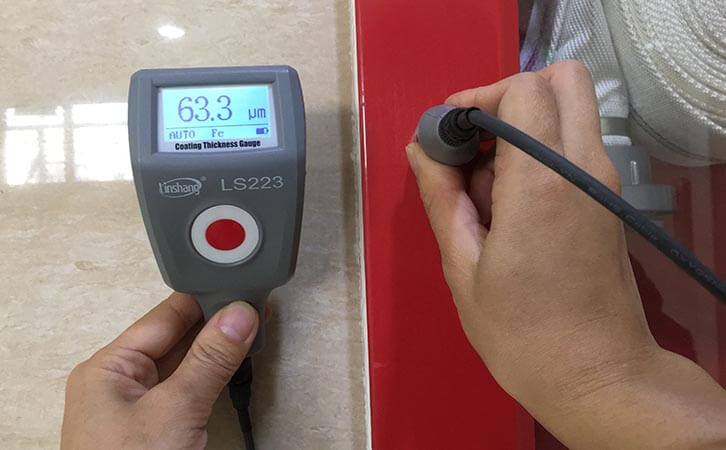Application of Coating Thickness Gauge in Aircraft Fireproof Coating Industry
Nowadays, because of the improvement of people's safety awareness, fire-resistant coatings have been applied in many places, such as the automobile, aircraft, subway and other industries. Fire retardant coatings can reduce the hazards caused by fire. When a fire occurs, fire-resistant coatings can prevent or delay the spread of fire. It can also protect the substrate by reducing the temperature of the substrate and consuming heat through chemical reactions. Fire-resistant coatings applied in different industries have different requirements on the coating thickness. Usually, a coating thickness gauge is used to detect the thickness of the fire-resistant coating.
1.Fire protection coating process
The current fire-resistant materials mainly include fire-resistant coatings, fire-resistant topcoats, primers, aluminum-clad aluminum panels, carbon fiber composite laminates and the like. The process of fire-resistant coating is as follows:
(1) First treat the substrate and clean the substrate to remove the surface oxide film.
(2) Spray the primer, spray the primer evenly on the substrate. And the thickness of the paint film measured by the coating thickness gauge after drying is 12.5-27.0 μm. Dry at a certain temperature and humidity for 12-48 hours and then brush the fire-resistant coating.
(3) Brushing of fire-resistant paint. Brush the fire-resistant paint on the primer-sprayed or non-primed aluminum plate to make a sample of the corresponding thickness. (The thickness requirements of fire-resistant coatings used in different places are different)
(4) Spraying of protective paint to protect the topcoat. After the fireproof coating is dried, spray paint on the surface and keep the surface uniform when spraying. And after drying, the dry film thickness should be measured with a coating thickness gauge to reach 15-25 μm.
2. Performance test of fire-resistant coating
After going through the above steps, we can perform a performance test on the material's fire-resistant coating. The thickness of the topcoat coating for fire-resistant coatings is very thick. When the thickness of the fire-resistant coating is measured by a coating thickness gauge of 0.8 mm. The thickness of the matching top coat is (20 ± 5) μm.
In the performance test, we use aluminum plate as the substrate to apply a 0.5mm fire-resistant coating with a primer topcoat, a 0.8mm fire-resistant coating with a primer topcoat and a 0.8mm fire-resistant coating without a primer. The test results are as follows:
(1) When the coating thickness is 0.5mm, the primer and topcoat are burned at the same temperature, the coating will swell and the degree of expansion will be obvious. The carbon layer will crack and fall off.
(2) When the coating thickness is 0.8mm with a primer topcoat, the fireproof coating will expand significantly at the same temperature, and the carbon layer will not crack and fall off.
(3) When the thickness of the coating is 0.8mm without primer, the fire-resistant coating will have obvious expansion and area cracking at the same temperature and the carbon layer will slag off.
3. Measure the thickness of the fire-resistant coating with a coating thickness gauge
According to the above experiments, it can be concluded that the fire protection effect would be the best when there is a primer and a top coat and the coating thickness reaches a certain requirement. Therefore, it is necessary to use a coating thickness gauge to measure the thickness of the fire-resistant coating. It is recommended to use Linshang LS223 coating thickness gaugeto measure the thickness of the fire-resistant coating. Linshang LS223 coating thickness gauge is equipped with two probes, F3N3 and F5N3. The thickest range can measure NFe: 0-3000μm and Fe: 0-5000μm. Users can choose the range that suits them according to their needs.
This coating thickness gauge has a ruby probe, which is resistant to wear and corrosion. Advanced digital probe technology makes the probe less susceptible to interference when collecting data and ensures measurement accuracy. The LS223 coating thickness gauge has three measurement modes. It can alsi switch function and set unit, making measurement very convenient.
- High precision coating thickness gauge for used car
- Automotive paint protection films coating thickness gauge
- Plating Thickness Measuring Instrument for Detecting Anti-corrosion Coating
- Linshang LS220, LS191, LS160A– Necessary for Car Cover Inspection
- Coating Thickness Gauge for Second Hand Vehicle
- Zero Adjustment Step of Coating Thickness Gauge
